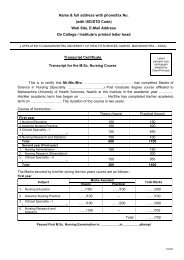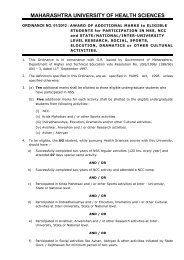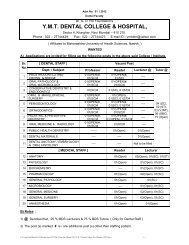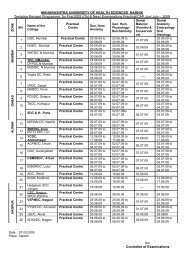Unit I
Unit I
Unit I
Create successful ePaper yourself
Turn your PDF publications into a flip-book with our unique Google optimized e-Paper software.
3. Epithelial tissueHuman body is made up of four basic tissues, epithelium, connective tissue, muscle and nerve tissue.Epithelium is a covering or lining tissue of all body surfaces, membranes and viscera. At many sites it formsglands which open and secrete on the epithelial surfaces. Epithelium is protective, secretory and absorptivein function. It rests on a basement membrane. It is classified according to the number of layers and shapeof the surface cells.Simple epithelium: It consists of only a single layer of cells arranged compactly in a contiguous manner..According to the shape of the epithelial cells it is subclassified into squamous, cuboidal and columnarvariety.Simple squamous (Squamous = scale like): It consists of single layer of very thin cells.Nuclei are thickerthan cytoplasm and create bulges on the membrane, easily seen under microscope in transverse section.The cytoplasm is so thin that it sometimes can not be seen under low power e.g. endothelial lining of bloodvessels, mesothelial lining of serous cavities and lining of thin segment of loop of Henle.Simple cuboidal:They do not actually have the shape of cubes but when cut at right angles to surface, theyappear cubical. There is less difference in the height and breadth of the cell (In a squamous cell length ismore and thickness is negligible) e.g. small collecting tubules in the medulla of the kidney, lining of inactivethyroid follicle, lining of the ovary.Simple columnar: Here the cells are more taller than wider. Surface view is hexagonal as that in cuboidalcells. Nucleus is basal, oval or elongated in shape.i) Simple columnar : It is unmodified variety, which provides protection and also secretes along wetsurfaces. Cytoplasm is light eosinophilic e.g. lining epithelium of gastrointestinal tract, gall bladder andlarger ducts of many glands.ii) Simple columnar ciliated: Luminal surface of the cells show cilia which beat to move the mucous alongthe membrane. Goblet cells are intermingled with ciliated cells e.g. lining of prepubertal uterus, centralcanal of spinal cord.iii) Simple columnar with goblet cells: Mucous-secreting cells are present in between the columnar liningcells. Due to mucous synthesis and accumulation they assume a bowl-like shape and indent the cytoplasmof neighboring cell. Its nucleus is in the narrow stem like portion close to the base. Mucous is washedduring H&E staining so they appear frothy, vacuolated or empty e.g. large intestine.iv) Simple columnar with microvilli: Apical surface of the cell shows the presence of microvilli. Underlight microscope it is described as cells having striated border or brush border. It increases the absorptivesurface area by 30 times. e .g. small intestine.Notes:13
















